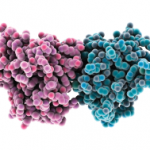Subsequent studies demonstrated decreased bone damage and inflammation, as well as decreased PAD activity and citrullination, in the arthritic limbs of the Cl-amidine-treated mice. “The key thing we’ve done is to show that the PADs are a target,” Dr. Thompson said in comments following the meeting. “It’s also possible that the compound could potentially be a therapeutic.”
However, there was no response when Cl-amidine was used in another model of arthritis called antibody-induced arthritis. In some respects, the lack of a response in the effector phase of the disease is worrisome, Dr. Thompson said. It is also unclear how closely this model mimics all aspects of arthritis in humans, he said.
Blocking Sphingosine Kinase 1
Gary Gilkeson, MD, was sitting on a graduate school committee several years ago when he heard a student involved in lipidomics research discuss the role of sphingosine kinase 1 (SphK1) in signaling by tumor necrosis factor a (TNFα). “Because of the critical role of TNF in rheumatoid arthritis, that got me interested in whether sphingosine was playing a role in rheumatoid arthritis and whether blocking it could be a potential therapy,” said Dr. Gilkeson, a rheumatologist and professor of medicine at the Medical University of South Carolina in Charleston.
His research group subsequently began working with transgenic mice in an effort to better understand the inflammatory role of the lipid-metabolizing enzyme. They obtained transgenic mice that expressed a modified copy of the human TNFα gene and thus were vulnerable to limb swelling and deformity. Then they crossed those mice with a second group, which lacked functional copies of the SphK1 gene.
In his presentation, Dr. Gilkeson discussed findings involving the two groups of mice, both of which carried a TNFα gene, but one with the SphK1 gene and the second with it knocked out.
Through scoring of pathology, the researchers determined that periarticular inflammation was reduced at both three months and six months in the mice which lacked the SphK1 gene. Bone erosion, measured at five months, also declined. The mice also demonstrated a reduction in synovial proliferation, but to a less significant degree.
It may be that SphK1 does not work on that synovial proliferation, while it does work on the pathway involved with inflammation and bone erosion, Dr. Gilkeson said in comments following the meeting. “We are trying to figure out where exactly sphingosine kinase is acting and how exactly it’s doing it,” he said.
